
views
Choosing a Tanning Salon and Bed Type

Go to a local tanning salon and ask about the tanning options they offer. Most tanning salons have a variety of bed styles available, and each use a different method to tan your skin. Speak with a representative at the salon, and have them pick the tanning bed that will work best for your skin. If there are multiple tanning salons in your area, shop around, compare salons, and choose the one you like most. Tanning salons will also often offer discounted tans if you purchase a monthly membership. If this is your first time using a tanning bed, only schedule an appointment for a single use. This way, if you do not like the results or if you decide tanning beds are not right for you, you are not committed to paying for a membership.
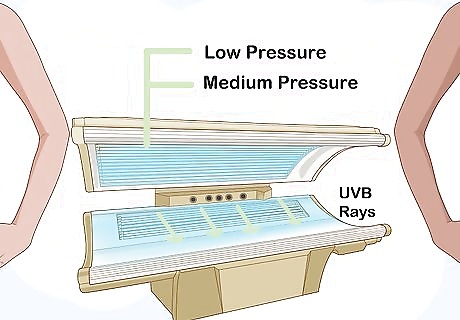
Use a low or medium pressure tanning bed to receive a natural-looking tan. Low and medium pressure tanning beds emit UVB rays in a spectrum that is similar to natural sunlight. The main difference is that medium pressure tanning operates at a higher wattage, and will tan your skin faster. While low pressure tanning is considered the traditional method of tanning because of its low reflector intensity, either of these will give you a natural-looking tan. Since the lamps in low and medium pressure tanning slowly emit the UVB rays, there is a risk of getting a sunburn. If you burn easily, consider using an alternative method.
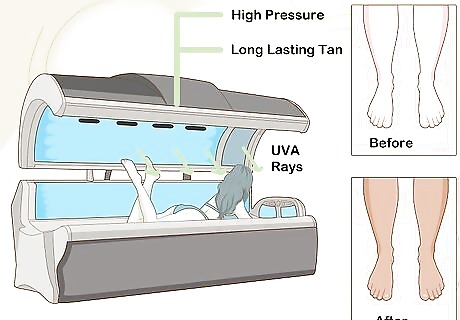
Lay in a high pressure tanning bed to get a long-lasting tan. High pressure tanning beds emit a higher proportion of UVA rays over UVB rays. The UVA rays will give you a deeper, longer-lasting tan that will build quickly without burning your skin. While this method is gentler on your skin, it also is usually the most expensive. If this is your first time tanning, refrain from using the high pressure tanning bed until you have become more experienced with the process. High pressure tanning builds a tan quickly, and if you are not readily familiar with the process you can easily wind up with tan lines.

Stand in a vertical tanning booth to get a quick and even tan. Since your skin is not pressing against any surfaces, you will get a more even tan and won’t have to worry about spots on your skin being missed. A vertical tanning booth is good for people who have never tanned before, or for people who are claustrophobic. If you are worried about having to flip and rotate your body inside of a tanning bed, book an appointment for a vertical tanning booth. You will get a 360 degree coverage just by standing with your arms and legs spread.

Examine the cleanliness of the beds before scheduling an appointment. You will be wearing minimal or no clothing when you use a tanning bed, so you want to make sure that the salon is reputable and maintains the cleanliness of the beds. If you see any dirt buildup on the beds, find a different place to tan. Ask what kind of cleaner the staff uses on the beds. Traditional glass cleaner will not remove or kill bacteria. A good way to determine the reputation of a tanning salon is by checking the customer reviews online. Read how customers like the tanning service and cleanliness of the place. If there are a significant amount of negative reviews, or even a few negative reviews that unsettle you, look for a different tanning salon.
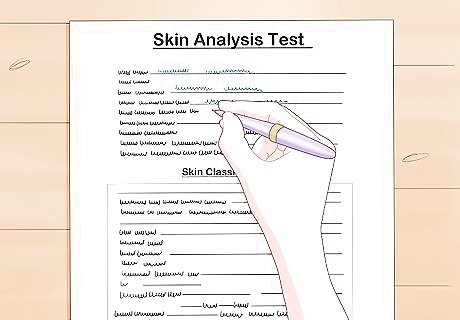
Fill out a skin analysis form to determine your skin type. The form will ask you basic questions concerning your hair, eye, and skin color, the sensitivity of your skin, and how often you tan. Salons use this form to determine the approximate time or tanning method best suited for your skin. Note any medication you are currently taking to avoid any side effects from getting the tan. While there are no laws against tanning if you are pregnant, tanning salons do reserve the right to turn you away. Tanning while pregnant can cause you to overheat, become dehydrated, feel ill, or even throw you into preterm labor. If you are pregnant, speak with your doctor and review the policies at the salon before booking an appointment.
Preparing Your Skin
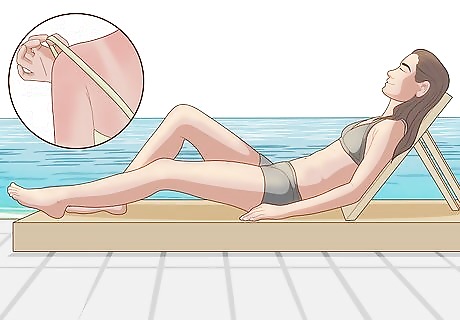
Build a base tan in natural sunlight to avoid skin irritation. This is especially important if you are going to be using a tanning bed that mostly emits UVB rays, or if your skin has not been exposed to sunlight all winter. This will get your skin accustomed to being exposed to the UV rays, and will minimize your chances of burning your skin in the tanning bed. You don’t necessarily have to tan outside to accomplish this. Simply take a few walks in the park, or partake in another outdoor activity. Still apply ample amounts of sunscreen to avoid burning or over exposing your skin.
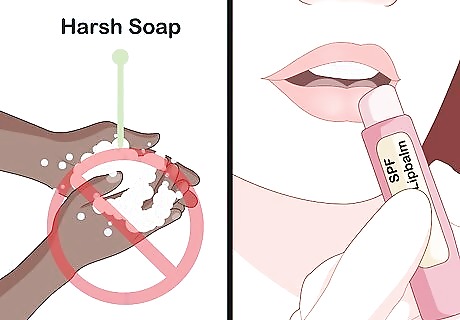
Exfoliate and moisturize your skin before your tanning appointment. Clean your skin and free it of any dead cells to ensure better tanning results. After you get out of the shower, apply a fragrance free moisturizer to your skin. The moisturizer will act as a barrier, and protect your skin from irritation or burning. Avoid using harsh soaps that will dry out or coat your skin with a residue. Soaps with shea butter or cocoa have natural moisturizing properties. Don’t forget to moisturize your lips as well. Your lips can easily dry out and burn while tanning, so make sure to apply a thick coat of your favorite SPF lip balm before laying in the tanning bed.

Refrain from wearing fragrant beauty or skin products to avoid skin irritation. When heated, certain fragrances and chemicals can cause irritation to your skin, or prevent your skin from tanning properly. Before going to your tanning appointment, skip using any beauty products like deodorant, perfume, or makeup. After receiving your tan, wait at least 24 hours to resume your normal beauty and skin care routine. Makeup and fragrant lotions can still cause irritation to your skin while the tan is settling.
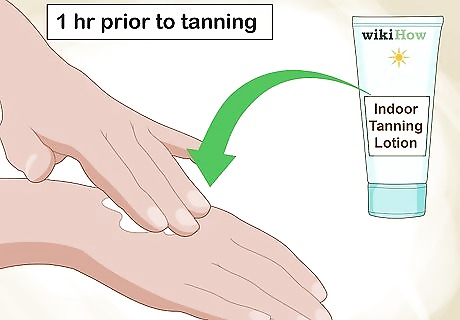
Apply an indoor tanning lotion about an hour before your appointment. Using a tanning lotion will increase the effects of the tanning bed. You do not have to use a tanning lotion before your appointment, but doing so might reduce the number of tanning sessions you have to have in order to achieve your desired tan. Do not use any outdoor tanning lotions or oils. Not only will these outdoor products not be effective, but the compounds might actually damage the tanning equipment.
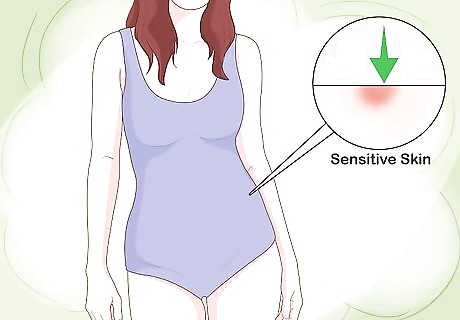
Wear a bathing suit to protect sensitive skin areas. Areas like your buttocks, breasts, and genitals are not used to being directly exposed to sunlight. To avoid skin irritation wear a bathing suit when you go tanning. If you opt for tanning nude, make sure to apply ample amounts of moisturizer to any areas that you believe will become irritated from the UV rays. Use a washcloth, hand towel, or tanning stickers provided by the salon to cover your nipples and genitals for most of your tanning session. Once you have experienced multiple tanning sessions, covering yourself will become less necessary. Some tanning salons do not permit nude tanning, so find out what the policies are before you strip down.

Cover recently dyed hair and tattoos to prevent them from fading. Steady exposure to UV rays can fade dyed hair and tattoo ink. Ask a staff member for a cap to cover your dyed hair, and find out what sunscreens are safe to use inside of the tanning bed so you can coat your tattoo. The UV rays will also yellow acrylic nails, so ask a staff member if they have coverings you can use to protect them.
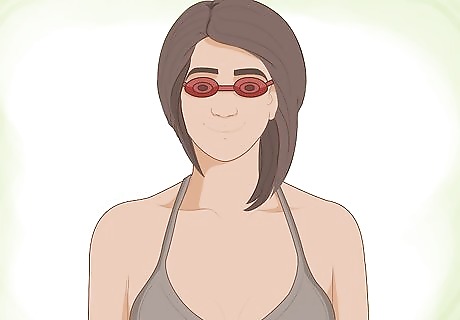
Wear goggles to protect your eyes while tanning. These will be given to you at the salon, or you can bring your own. Even with your eyes closed, the intensity of the UV rays emitted in the tanning bed can irritate or even damage your eyes. Overtime, excess exposure to UV rays without proper protection can lead to color blindness, loss of night vision, developing cataracts, and blindness. You can avoid getting pale circles, or “raccoon eyes,” from the goggles by sliding the goggles periodically throughout your tan. Just do not remove or lift the goggles completely. Never wear contact lenses while tanning as they can dry out or damage your eyes.
Positioning Your Body in the Tanning Bed

Ask a staff member to go over the tanning process with you. This is especially important if this is your first time tanning, or if you are using a type of bed you are unfamiliar with. Some tanning beds will have buttons for you to personally control the fans that circulate the air, or some will have separate light bulbs you can turn on and off to tan your face. Depending on the salon, you may also have to close the lid to the tanning bed and turn the machine on when you are ready to start. Make sure you know how all of these functions work before laying down in the bed.
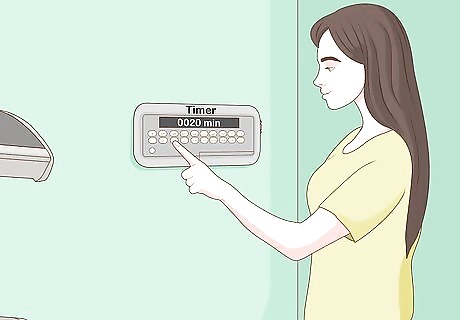
Locate the countdown timer for your tanning session. Not every salon will have a staff member tell you when to flip your body during the tanning session. Standard tanning beds will have a timer visible on the inside, so you can monitor your own session. It is important to know where this timer is, or if you will be receiving guided instructions during your tanning session. The timer is set by a staff member beforehand with a time determined by the skin analysis form you filled out. If you have fair or sensitive skin, your first tanning time will most likely not exceed 6 or 7 minutes. If you have a base tan or darker skin, your tanning time can be as long as 20 minutes.
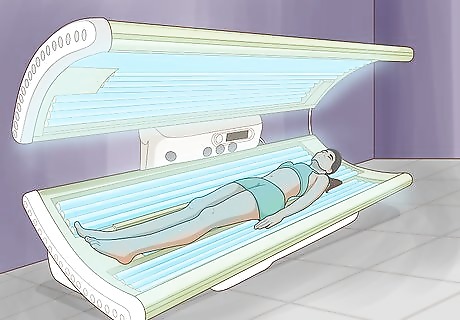
Lay on your back inside the tanning bed with your arms and legs spread. Laying with your legs together or with your arms resting against your sides can lead to an uneven or spotty tan. Stretch out your body when you first lay down to ensure all parts of your skin get exposure. If you want to particularly tan the skin underneath your arms, lift your arms over your head for a few minutes to tan.

Bend your knees to avoid getting tan lines on the back of your upper thighs. When you lay your legs flat, your buttocks pushes against the back of your thighs. Tanning like this will result in embarrassing tan lines. To avoid this, bend your knees so your legs are slightly elevated. Make sure that your inner thighs don’t press together when you do this, otherwise, you will get an uneven tan there. If there is not enough room inside the tanning bed for you to bend both of your knees at the same time, bend one knee for a few minutes and then switch to the other.
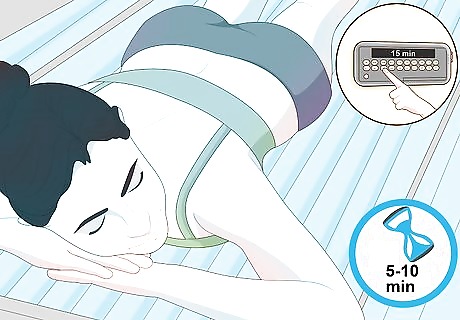
Flip onto your stomach halfway through your tanning session. In order to tan your backside, adjust your positioning so you are laying on your stomach. Place your arms at your sides with your palms down. This is usually indicated by a timer or a staff member telling you to flip over. Since this position can feel uncomfortable, you can bend your arms to prop up your chin. If you are getting your tan in a vertical booth, you do not have to worry about rotating your body to receive an even tan.

Rotate your body so you are laying on your side. Dedicate the last minute of your session to tan your sides. While the bed has been indirectly tanning your sides throughout the session, spending at least 30 seconds laying on each side will ensure that your tan is even around your entire body.
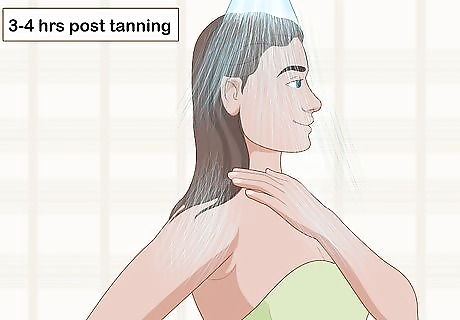
Wait 3 to 4 hours to bathe after tanning. The tan needs time to soak and settle properly into your skin. If you shower right after tanning, it can dull your tan or even create splotchy marks within the tan. If your skin feels particularly dry, rehydrate it by generously applying moisturizer.
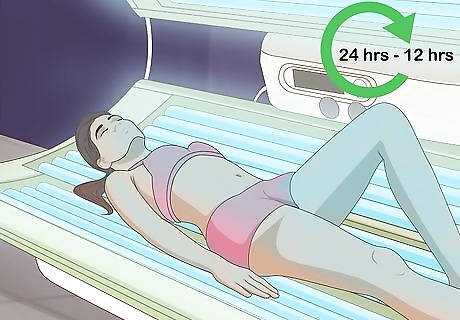
Maintain your tan by revisiting the salon, or by using tan extenders. Your tan will continue to darken over the next 24 to 72 hours. If after that time you are not happy with the results, make another appointment. Some people take 2 or 3 sessions before they achieve their desired golden glow. You can also use tanning extender products to make your tan last longer between visits. Safely expose your skin to the sunlight to keep the bronze pigment in your tan. If you constantly conceal your skin after receiving your tan, it will quickly fade.

















Comments
0 comment